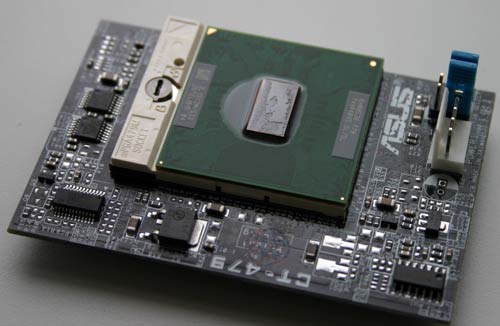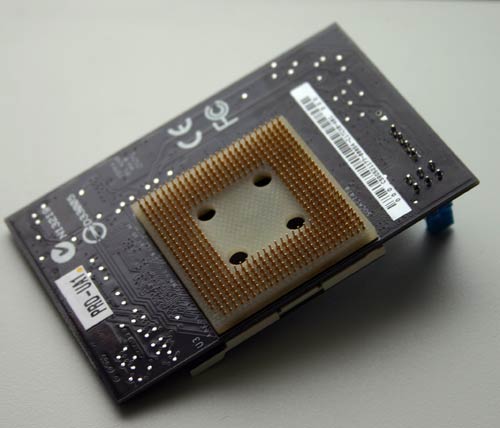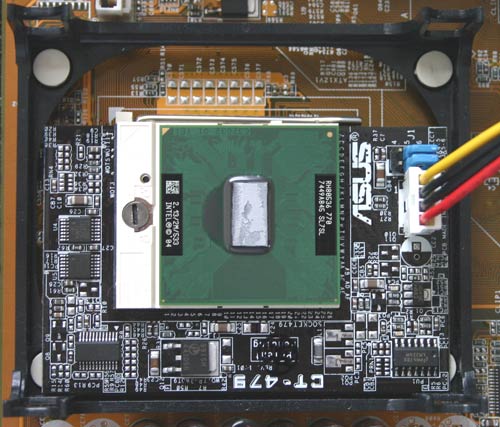Intel's Pentium M Desktop Part II: ASUS' Pentium M to Pentium 4 Socket Adapter
by Anand Lal Shimpi on March 24, 2005 1:31 PM EST- Posted in
- CPUs
ASUS CT-479: Socket-478 to Socket-479 Adapter
Enter the ASUS CT-479 CPU Upgrade Kit, an adapter board that will convert specific ASUS Socket-478 motherboards to support Pentium M CPUs. You will remember from our original Pentium M desktop article that the pinout of the Pentium M is different than the Pentium 4, although the two chips are electrically compatible (they use the same FSB). The next problem is that the Pentium M relies on a much lower voltage version of the Pentium 4's FSB, which is also addressed by ASUS' adapter, a problem that we did not think was solvable until now.
The CT-479 only works with ASUS motherboards, and only a limited number of them at that. Currently, only the ASUS P4P800-SE and P4P800-VM motherboards are supported, both of which are i865 based motherboards. ASUS is working on support for other boards; the P4C800-E (875P) will be supported soon. For our tests, we used a P4P800-SE; you need a BIOS update, but that's all. Obviously, non-ASUS motherboards are not supported; however, we're not certain whether or not the adapter can be made to work in other boards. We will be looking into this as time goes on, but we wanted to make sure that we could complete this article first before doing anything that would damage our setup.


The CT-479 supports all Pentium M and Celeron M CPUs (Dothan and Banias based) with the exception of the Low Voltage and Ultra Low Voltage versions.

The jumpers switch between 400 and 533MHz FSB settings. The power connector powers the adapter.
The CT-479 comes with the adapter board, heat sink/fan and power cable.

A perfect fit

The supplied heat sink is specifically made for the CT-479.
Currently, ASUS is listing the CT-479 as a part of a bundle with the P4P800-SE, priced at $130. At that price, the solution is almost half the price of the AOpen/DFI motherboards, and you get all of the benefits of the 865 chipset. The main benefit of the 865 chipset in this case is its dual channel DDR400 memory controller. The 533MHz FSB Pentium Ms are memory bandwidth starved by the 855GME's single channel DDR333 memory controller, so being paired with an 865 gives the CPU more memory bandwidth than it can use.
The P4P800-SE that we tested only allowed for 5:4 and 1:1 memory clock speed ratios, meaning that for our 533MHz FSB Pentium M, the maximum stock memory clock was DDR333. But since we're talking about a dual channel memory controller, even at DDR266 speeds, you have enough memory bandwidth for the processor - DDR400 support isn't necessary.
The other major benefit of the CT-479 is that you get to use a mature, mass-produced ASUS motherboard instead of a smaller production run, recently released 855GME solution. The benefits were clear in our testing - overclocking the Pentium M was far less of an ordeal on the ASUS solution.
The CT-479 does not support the Pentium M's SpeedStep technology, which has a handful of implications:
1) System power consumption will be higher on the ASUS solution than on 855GME based systems from AOpen/DFI. The reason being that the CPU will always run at maximum frequency, which is still lower power consumption than any other desktop processor, but it is worth mentioning.
2) You can't adjust the clock multiplier of the Pentium M like you can on the AOpen/DFI offerings. This will hamper the more adventurous overclockers, but it's definitely not a show stopper.
You also can't adjust the Pentium M's core voltage when using the CT-479; you're stuck at the default voltage. ASUS' Q-Fan technology (which allows for the automatic reduction of fan speed depending on thermal load) is supported, so you can reduce noise output even if SpeedStep isn't supported.
ASUS just announced the CT-479 last week, so there are some details that aren't yet available, such as whether or not the kit will be offered outside of the ASUS motherboard bundle. As soon as we have this information, we'll pass it along, but even if the only way to get it is with an ASUS motherboard, it is still a much better value than a standalone Pentium M motherboard.
The question here is how big of an impact does the 865 chipset have on the desktop performance of the Pentium M? To find out, we paired it with the Pentium M 770, Intel's fastest Pentium M running at 2.13GHz. The Pentium M 770 requires a 533MHz FSB, which is supported by the 865 chipset, and thus, is also supported by the CT-479 upgrade kit.
The Test
Our hardware configurations are similar to what we've used in previous comparisons.
AMD Athlon 64 Configuration
Socket-939 Athlon 64 CPUs
2 x 512MB OCZ PC3200 EL Dual Channel DIMMs 2-2-2-10
NVIDIA nForce4 Reference Motherboard
ATI Radeon X800 XT PCI Express
Intel Pentium 4 Configuration
LGA-775 Intel Pentium 4 and Extreme Edition CPUs
2 x 512MB Crucial DDR-II 533 Dual Channel DIMMs 3-3-3-12
Intel 925XE Motherboard
ATI Radeon X800 XT PCI Express
Intel Pentium M Configuration
Intel Pentium M 725 - 755
2 x 512MB OCZ PC3200 EL Dual Channel DIMMs 2-2-2-10
AOpen GMEm-LFS Motherboard
ASUS P4P800-SE + CT-479 Adapter
ATI Radeon X800 XT AGP










48 Comments
View All Comments
ElFenix - Sunday, March 27, 2005 - link
i'm confused, were all the benches done at 5:4 memory ratio? how is the performance at 1:1? if the added bandwidth from running 5:4 can't be used, isn't it better to run synchronus?joe360 - Saturday, March 26, 2005 - link
I have a socket-478 P4 2.8 Presscott in a laptop, is there a way I can get the Dotan in there instead?Hardtarget - Friday, March 25, 2005 - link
Wow thanks for the update Anand. I just read both of these articles and was extremely impressed with them.Real good work, I can't wait for the Yonah just to see what happens!
drewski - Friday, March 25, 2005 - link
i agree w/ posts 9, 18, & 28 regarding the changing of multiple variables making some of the comparisons between architecture's a bit of a guess.thanks for your post, Anand. it helps clarify things, though having the benches would help. maybe you can cut and paste it into the article! ;-)
still, i think this was less of an oversight than that terrible article on the OCZ Vx memory by Wesley. has that ever been corrected?
Anand Lal Shimpi - Friday, March 25, 2005 - link
For those wondering about the 865 vs 855 comparison, one thing I tried to stress in the article (especially during the benchmark comments) is that in many cases the performance improvement was barely anything, thus meaning that the magic solution to the Pentium M's desktop viability was far from just add more memory bandwidth. The reason that point is important is because after the first article, many assumed that more memory bandwidth and a faster FSB would make the Pentium M infinitely more competitive. But look at media encoding and the majority of the MCC tests and those two improvements didn't change things all that much.The Pentium M 770 has a 6.65% increase in core clock speed over the Pentium M 755, in any benchmark where the 770 offers a greater than 6.65% increase in performance you know that performance improvement is due to more than just the clock speed, mainly the faster FSB and the correspondingly higher memory bandwidth. Since the 855GME is already memory bandwidth limited with a 400MHz FSB, increasing the bus frequency to 533MHz won't do anything for performance on that chipset, so that's why you can attribute the performance gains that do exist to the 865 platform as a whole. Also keep in mind that most applications rarely scale at a 1:1 ratio with CPU clock speed; even some of the more CPU limited applications will scale at a 50% rate with clock speed - so really what you're looking for are any performance improvements greater than about 3%, those are due to the 865 platform.
There are a few areas where the added memory bandwidth does make a huge difference - mostly in the workstation level SPEC tests.
So although we didn't run direct comparison numbers between the 855GME and the 865, there is enough information in this article to (as many of you have already concluded) find out that for the most part, the added memory bandwidth does very little (on the order of a few percent). The real benefit of the ASUS solution is that you get a much more mature motherboard, more stable, and a lot cheaper. I apologize if I didn't properly stress this information throughout the article and in the conclusion.
Take care,
Anand
PrinceGaz - Friday, March 25, 2005 - link
#31- the P-M 770 has a 533MHz FSB. That's how fast data moves to and from the northbridge memory-controller. The CPU doesn't care about whether the chipset memory-controller is single or dual-channel. Using dual-channel DDR333 provides 667MHz of memory bandwidth for the northbridge, of which the P-M 770 will utilise a maximum of 533MHz (when not overclocked), so it is taking advantage of dual-channel.Unfortunately, as others have pointed out, the article was very poor because there was no comparison of the same P-M on the i855 (single channel) and i865 with adapter (dual channel) chipsets. The purpose of the article was to see what effect the adapter and i865 had on performance. Of course the P-M 770 on the i865 was faster than the P-M 755 on the i855, because the P-M 770 has a higher core speed. What you did was like comparing a S754 3000+ (2GHz) and a S939 3500+ (2.2GHz), and concluding that S939 provides a good performance boost over S754 because it is dual-channel, whilst overlooking the clock-speed difference which has a much greater impact.
classy - Friday, March 25, 2005 - link
I don't even see this even as a viable solution. It is a real dog in many instances and the biggest problem is you have to overclock it. Now for many of us that is not a problem, until you factor in that your talking about a rather extreme overclock, even for an Intel Processor. If you can't reach these speeeds with a low priced one, only a fool would buy one. Especially now since I can go over to Zip and buy a retail AMD 64 4000+ for $550 dollars. And don't forget AMD 64 chips overclock fairly well too. If this was 2 years ago it would be viable or even if was say the priced like an XP or 64 3000+ chip you might consider it. But given the necessiity that it has to be overclocked to get good performance, high price, and extremely limited platform support I see no reason whatsoever to buy a Pentium M. And I am running an Intel setup as I type this. They have just fallen behind and it doesn't look like they are going to catch up any time soon either.fitten - Friday, March 25, 2005 - link
Something to remember about the PentiumM, while the chipset it sits on may be dual channel memory, the PentiumM itself, is not. It's much like the Athlon XPs and the nForce2 chipset (CPU is single channel, chipset is dual channel). So, you really aren't comparing a "real" dual channel processor like the S939 and S940 Athlon64/Opterons. The PentiumM can only pull data in one channel width per read, regardless of the chipset it sits on. The S939/S940s can pull in two channel widths per read.That being said, there definitely seems to be some improvement in going to the hybrid dual channel boards.
Quanticles - Friday, March 25, 2005 - link
What about HL2 preformance when it's not overclocked?xsilver - Friday, March 25, 2005 - link
Where this cpu would really work is in a xpc system where extreme performance isnt really nessessary... but think of running the whole pc on only the 1 PSU fan